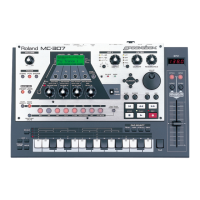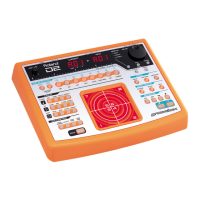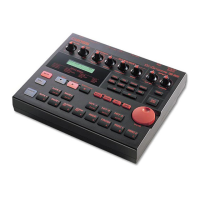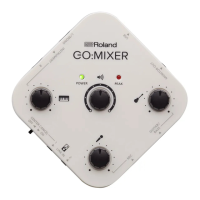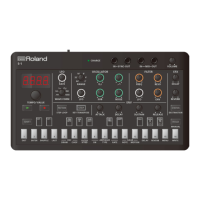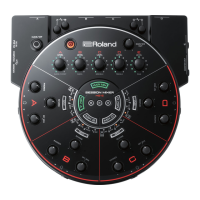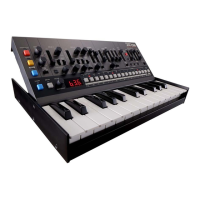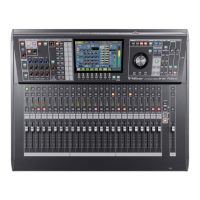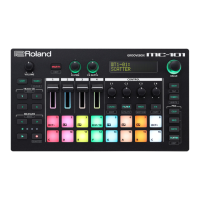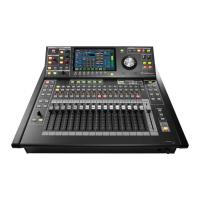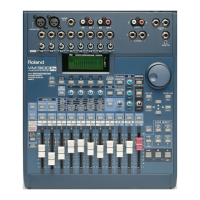43
Editing the TONE Track
MIX
Here you can set the reverb, delay, pan, and level of the total eect.
Parameter Value Explanation
LEVEL
(MIX LEVEL)
0-127 Species the volume of the clip.
PAN L64-63R Species the pan of sound.
>REVERB
(Reverb Send) 0–127
Species the amount sent to TOTAL FX
REVERB.
>DELAY
(Delay Send) 0–127
Species the amount sent to TOTAL FX
DELAY.
FILTER
Here you can make lter settings.
Parameter Value Explanation
TVF TYPE
OFF, LPF, BPF, HPF,
PKG, LPF2, LPF3
Selects the type of TVF lter.
OFF: O
LPF: Low pass lter
BPF: Band pass lter
HPF: High pass lter
PKG: Peaking lter
LPF2: Low pass lter 2
LPF3: Low pass lter 3
VCF TYPE
FLAT, TYPE-JP,
TYPE-M, TYPE-P
Selects the type of VCF lter when the lter
TYPE is VCF.
Each of these simulates the operation of an
analog synthesizer’s LPF.
TYPE TVF, VCF
Select either TVF or VCF as the lter type.
* TVF stands for Time Variant Filter, and is a
lter that allows detailed settings to be made
for the time-varying change in the sound’s
frequency components.
If VCF is selected, the simultaneous
polyphony will be less than when TVF is
selected.
CUTOFF
(Cuto ) 0–1023
Selects the frequency at which the lter
begins to have an eect on the waveform's
frequency components.
RES
(Resonance) 0–1023
Boosts the region of the sound near the
cuto frequency, adding a distinctive
character to the sound.
ENV DEP
(Env Depth) -63–+63 Species the depth of the lter envelope.
KEYF -200–+200
Set this if you want the cuto frequency to
change according to the keyboard position
of the note you play.
SLOPE
-12, -18, -24 [dB/
Oct]
This button selects the slope (steepness) of
the lter.
For VCF, you can choose -12, -18, or -24.
For TVF, you can choose only -12 or -24.
If the lter TYPE is TVF, the following
limitations apply.
Only -12 dB or -24 dB can be specied.
Even if you specify -18 dB, the sound
engine operates internally with the -12 dB
setting.
If you specify -24 dB, the simultaneous
polyphony will be less than when -12 dB is
selected.
AMP
Here you can make amp envelope settings.
Parameter Value Explanation
ATTACK
(T1) 0–1023
Species the time over which the initial
value changes to the maximum value after
the key is pressed.
DECAY
(T3) 0–1023
Species the time over which the SUSTAIN
value is reached following the ATTACK.
SUSTAIN
(L3) 0–1023
Species the sustain value of the amp
envelope.
RELEASE
(T4) 0–1023
Species the time over which the minimum
value is reached after the key is released.
PAN PTL1–4
(Pan) L64–63R Species the pan of each partial’s sound.
EQ
Here you can make equalizer settings.
Parameter Value Explanation
SW OFF, ON Turns the equalizer on/o.
LOW -24–+24 [dB] Gain of the low frequency range.
MID -24–+24 [dB] Gain of the mid frequency range.
HIGH -24–+24 [dB] Gain of the high frequency range.
MIDQ 0.5–16.0
Bandwidth of the mid frequency range.
Set a higher value for Q to narrow the
range to be aected.
LOW 20–16000 [Hz] Frequency of the low range.
MID 20–16000 [Hz] Frequency of the mid range.
HIGH 20–16000 [Hz] Frequency of the high range.
EFFECT
Here you can make eect settings.
Parameter Value Explanation
SWITCH OFF, ON Turns the eect on/o.
TYPE
Refer to the MFX/
IFX parameters.
Switches the type of eect.
Eect parameters
The displayed parameters depend on the
eect type that is selected.
Detailed Sound Editing
How a Tone Is Constructed
A tone consists of four (Partial 1–4) sets of OSC, Filter, AMP, LFO × 2, and
EQ settings, together with multi-eect (MFX) settings.
You can create sounds by combining the four partials.
Each partial can be turned on/o, allowing you to select which partials
produce sound.
Partial 4
Partial 3
Partial 2
Pitch Env Filter Env Amp Env
LFO 2
LFO 1
OSC Filter
Amp
Partial 1
EQ
MFX
OSC (oscillator)
This selects the waveform that is the basis of the sound, and
species how its pitch will change.
Filter
This modies the frequency components of the sound.
Amp (amplier)
This creates changes in volume and pan.

